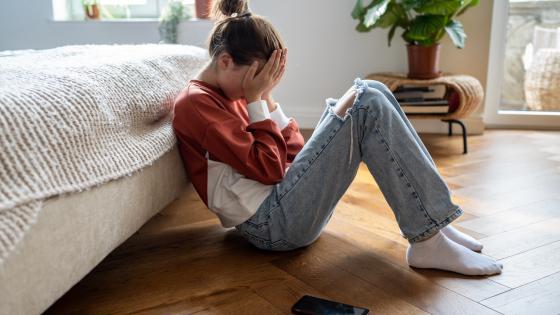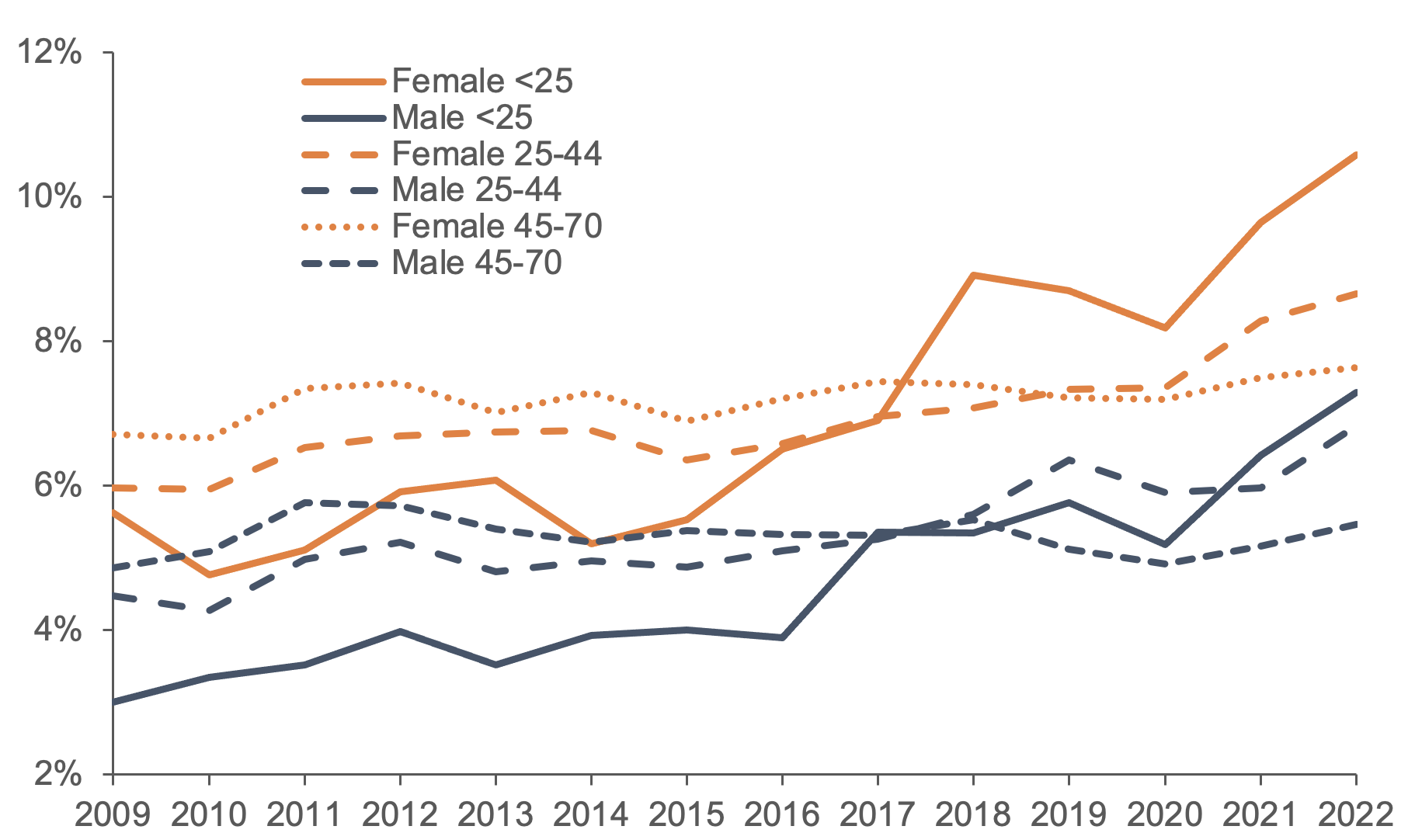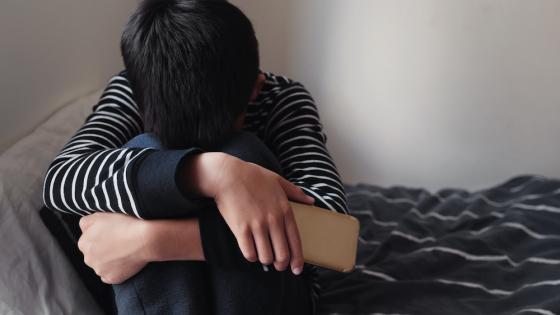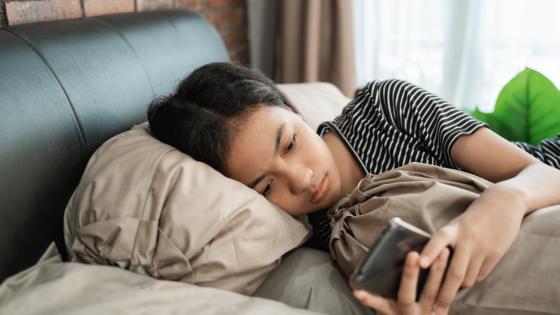A consensus is emerging that we face a mental health crisis, particularly among the young and most of all among young women. This trend goes back over ten years to the period after the Great Recession, and is apparent in the US, the UK, and elsewhere.
Figure 1 presents evidence for the US on the growth in despair from the Behavioral Risk Factor Surveillance System (BRFSS), measured as the percent who say every day of their lives is a bad mental health day. This rose dramatically from 2011, well before COVID. In a new study, we confirm this upward trend in young people’s poor mental health across several surveys (Blanchflower and Bryson 2024a).
Figure 1 Despair by age in the US, 2009-2022
Note: The figure plots trends in despair in the United States from 2009 to 2022 using the Behavioral Risk Factor Surveillance System (BRFSS) surveys (https://www.cdc.gov/brfss/index.html). The despair measure is based on those who gave the answer 30 to the question. “Now thinking about your mental health, which includes stress, depression, and problems with emotions, for how many days during the past 30 days was your mental health not good?” The figure plots the proportion of people saying that in the past 30 days all were bad mental health days.
Source: Xu et al. (2024)
The severity of the crisis is also apparent in rising suicide rates among under-25s, which rose sharply from around 2007, especially among women (Keyes et al. 2019, Spiller et al. 2019). It is also found in a dramatic rise in the taking of anti-depressants among the young, and especially so for young women since 2020 (Chua et al. 2024).
But why is mental ill-health rising, especially among the young?
One factor may be the potential ‘scarring’ effect of the Great Recession on new cohorts entering the labour market – the wellbeing analogue of the scarring effects of recession on new cohorts’ subsequent labour market prospects. It is possible that, because the labour market did not recover quickly after the Great Recession – as indicated by real wage stagnation – successive cohorts of new entrants may have been impacted in the years following the Great Recession shock. Of course, the Great Recession impacted the labour market prospects and household income for older people too, potentially explaining the deterioration in their wellbeing. But, as in the case of labour market scarring, effects may be felt most and persist for longest among the young.
However, any labour market explanation cannot account for the precipitate decline in adolescent mental health – well before they ever get close to working age (Daly 2022a, 2022b). By 2021, approximately 57% of female high school students felt so sad or hopeless almost every day for at least two weeks in a row that they stopped doing their usual activities – up from 36% in 2011. For males the figures were 29% and 21%, respectively (CDC 2023). Most worryingly, 30% of female high school students had seriously considered suicide, up from 19%, although there was little change among males (14% in 2021 and 13% in 2011). These findings suggest that factors other than labour market conditions must also be contributing to the relative decline in young people’s mental health.
Three other, potentially complementary, hypotheses might account for the marked decline in wellbeing among the young. The first is the depletion of health care resources available to treat mental health conditions. Ever since the Great Recession, monies available for publicly provided healthcare services have been stretched. There is recognition in both the US and the UK that mental health services are acutely underfunded (Case and Deaton 2020) such that delays in access to treatment may have prolonged the duration of spells of poor mental health which, in cross-sectional data, will be evident in an increase in the ‘stock’ of individuals suffering from poor mental health.
The second hypothesis relates to the advent of smartphone technologies and the way they have impacted young people’s perceptions of themselves and their lives relative to their peers’ portrayal of their lives via social media. This new information about the lives others appear to lead may result in greater dissatisfaction with one’s own life (Makarin and Braghieri 2022). The growth in smartphone usage coincides with the rising trend in ill-being (Xu et al. 2024). Smart devices became increasingly popular as the price of accessing smart phone technology fell, leading to increased reliance on social media outlets as a chief source of information for young people on all matters in their lives including social networking, dating, online entertainment, and news. The coincidence in the timing between growing access to smartphone technology and declining wellbeing among the young is insufficient to support a causal inference about the role of social media, but studies that randomise restricted access to smart phones identify significant improvements in self-reported wellbeing (Pedersen et al. 2022, Braghieri et al. 2022).
In recent analyses of the Youth Risk Behavior Surveillance System Surveys 2003-2021, we found a marked rise in screen time among high school students aged 14-18 which was strongly associated with rising mental ill-being, as well as being an avenue for cyberbullying (Blanchflower and Bryson 2024a). The weight of findings has led to calls for restrictions on young people’s access to smartphone technology and in the regulation of social media content.
The third potential contributor is the role played by adverse childhood experiences (ACEs), which directly impact mental health of the young, with effects persisting across the life-course (Blanchflower and Bryson 2024b). According to the Behavior Surveillance System Surveys (BRFSS), these ACEs – which include living with others who are mentally ill, or have drug or alcohol problems; being bullied, physically or sexually abused; and parental neglect – have been on the rise, particularly among young women. We show that these ACEs are among the factors that most strongly raise the probability of poor mental wellbeing, whether measured as bad mental health days or distress or sadness and hopelessness. Of those young females who said they were in despair in the years 2020-2022, four out of five of them reported having one or more ACEs and 35% had three or more. Of those who did not report being in despair, two out of ten had one or more ACEs and 12% had three or more.
Mental ill-health, on a variety of measures and across several data sets, is on the rise in the US and elsewhere. Of particular concern is the dramatic increase since 2011 in mental ill-being among those under the age of 25 and especially young women. This is an international crisis that requires immediate attention. The concern is that the worsening of mental health is likely to have major labour market consequences but perhaps more worryingly, a rise in suicide rates.
References
Blanchflower, D G and A Bryson (2024a), “The consequences of abuse, neglect and cyber-bullying on the wellbeing of the young”, NBER Working Paper No. 32119.
Blanchflower, D G and A Bryson (2024b), “The adult consequences of being bullied in childhood”, Social Science and Medicine 345: 116690.
Braghieri, L, R Levy and A Marakin (2022), “Social media and mental health”, American Economic Review 112(11): 3660-3693.
Case, A and A Deaton (2020), Deaths of Despair and the Future of Capitalism, Princeton University Press.
CDC – Centers for Disease Control and Prevention (2023), “Youth Risk Behavior Survey data summary & trends report, 2011-2022”, Washington DC.
Chua, K P, A Volerman, G Zhang, J Hua and R Conti (2024), “Antidepressant dispensing to US adolescents and young adults: 2016-2022”, Pediatrics 153(3).
Daly, M (2022a), “Cross-national and longitudinal evidence for a rapid decline in life satisfaction in adolescence”, Journal of Adolescence 94: 422-435.
Daly, M (2022b), “Prevalence of psychological distress among working-age adults in the United States, 1999–2018”, American Journal of Public Health 112: 1045–1049.
Garriguet, D (2021), “Health of youth in Canada”, in Portrait of Youth in Canada: Data Report, Statistics Canada.
Keyes K M, D Gary, P M O’Malley, A Hamilton and J Schulenberg (2019), “Recent increases in depressive symptoms among U.S. adolescents: Trends from 1991 to 2018”, Social Psychiatry and Psychiatric Epidemiology 54(8): 987-996
Makarin, A and L Braghieri (2022), “Social media and mental health”, VoxEU.org, 22 July.
Pedersen, J, M G B Rasmussen, S O Sorensen, S R Mortensen, L G Olesen, S Brage, P L Kristensen, E Puterman and A Grontved (2022), ‘Effects of limiting digital screen use on well-being, mood and biomarkers of stress in adults’, npj Mental Health Research 1: 14
Spiller H A, J P Ackerman, N E Spiller and M J Casavant (2019), “Sex- and age-specific increases in suicide attempts by self-poisoning in the United States among youth and young adults from 2000 to 2018”, Journal of Pediatrics 210: 201-208
Xu, X, D G Blanchflower and A Bryson (2024), “The declining wellbeing of the young”, UCL, mimeo.




